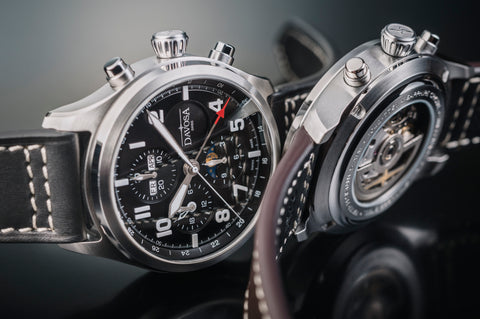Watch Jewels Bearing - The Ultimate Guide
Jewels are those mysterious elements tucked inside our watches, and they have a name that has always aroused suggestive scenarios made of gentleman thieves and golden jet-set atmospheres. So much that in the most fanciful plots, some watches were stolen for the preciousness of the jewels contained inside (perhaps they were adorning the watch crown)!
Even though the reality is much more prosaic, and jewels have a much more utilitarian function, we will discover why jewels are so essential in a watch and explore their history and craftsmanship, which is still suggestive!
What is a Jewel in a watch?
Jewels, also known as stones, are - nowadays - tiny artificial rubies, usually shaped in the form of a toroid with a central hole. They are used as bearings to support the wheel train in watches. Jewels are generally mounted in pairs so that the pivots of the watch's single gear, known as the wheel, can rotate with as little effort as possible.
In addition to the regular jewels, there are other types of stones. They are not drilled and are generally called counter-stones because they are applied on top of them. The counter-stones' function is to protect the stones and create a small space known as an oiler where the wheel pinion rests. Typically, counter-stones are used on the balance wheel.
The use of jewels in watchmaking is ancient, dating back to around 1700. A Swiss emigrant to Great Britain, Nicolas Fatio de Duillers, together with his compatriots Peter and Jacob Debaufre, first developed the technique to pierce the stones, thus allowing them to be used as bearings for the pivots of the wheels. This technique, which was patented and kept secret, determined the technical supremacy of English watchmaking until the end of 1700 when the French Ferdinand Berthoud finally managed to replicate the same results obtained by Fatio, and the use of jewel bearings spread throughout the continent.
As a note, watch crystals and watch jewels are two different things altogether: the crystal is just another name to indicate the glass protecting its dial, while the jewels are used for the movement.

What is the purpose of a jewel bearing?
One of the main problems with any mechanism is friction. Friction is caused between two interacting surfaces, resulting in progressive wear of materials. The best ways to defeat friction are to oil the mechanism and use more rigid materials that don't wear out with use - which is precisely why jewels were introduced into watches.
The first jewels were machined natural stones. If we look at the Mohs scale, measuring the hardness of materials, we can see that stones, in general, are much harder than steel, and because of this, they provide less friction. For example, a standard clock mechanism consists of two metal plates, usually brass, which support a wheel mounted on a steel staff. The coefficient of friction of brass-on-steel is 0.35. Instead, we consider that of a stone such as sapphire - which is of the same family of corundum to which the ruby belongs - we see that the coefficient is only 0.10-0.15. Moreover, unlike metals, stones are less subject to temperature, so they do not expand.
This means that, in general, a movement using jewels will have a smoother action, be more durable, need less maintenance over the years, and be more accurate. As a note, the use of stones is not restricted to mechanical movements: the best quartz watches also use jewels for the wheel train.
Do watch jewels ever wear out?
Any material subjected to friction will wear out eventually, so jewels, too, are subject to this phenomenon over time. Above all, if watches are not serviced at regular intervals, abnormal wear can occur for various reasons, leading to the holes of the stones becoming oval. In this case, it is necessary to intervene on the watch and replace the jewel with a new one. Although not "routine," this intervention is less complicated than it might appear, especially when the movement is equipped with stones mounted in a bezel.
Movements without jewels are even more prone to this phenomenon than those with stones, and in the case of wear, it is necessary to drill a hole in the plate and insert a new piece of metal cut to size.
What jewels are used in watch movements?
The first jewels used in movements were chips of natural stones, primarily quartz, garnet, and all types of corundum, such as rubies and sapphires, which proved to be the best material for creating these elements. The original jewel-making technique involved using tools covered with diamond dust, so corundum, which has a degree of hardness just below that of diamond, was the best stone for this use.
This very labor-intensive, and thus, expensive workmanship made watch jewels a true luxury until the late 19th century when chemist Auguste Verneuil discovered the process for producing synthetic corundum in the laboratory - stones that were free of the problems and defects of natural stones. Thanks to Verneuil's discovery, rubies used in modern mechanical watches are of excellent quality and highly affordable.

What is the highest number of jewels in a watch?
As we said, jewels are instrumental in making watches more accurate, and they began to become well-used in watchmaking, especially in the twentieth century. This coincided with the industrial production of watches and, therefore, with the evolution of mass advertising.
The topic of jewels has always had a lot of hold among the public. So much so that over the years, the idea began to diffuse that the more jewels there were in a watch, the higher its quality - and this led some companies to insert unnecessary stones inside the movement, used only for advertising purposes. In fact, there are examples of timerpieces that have as many as 100 jewels, typically inserted in correspondence with the central rotor of the watch movement to avoid its contact with the upper plate.
It must be said that the industry, since the seventies, has been self-regulated. Today this advertising practice is no longer allowed: today, it is allowed to declare only the number of really useful jewels used inside the watch, which start from 17 for a manual movement and arrive more or less to 25 in automatic watches. Obviously, the more complications there are, the more this number can increase, but in most cases, the amounts of jewels lie in this range.
Main Takeaways
Although the topic of watch jewels may seem a bit technical and irrelevant to watch buyers, it has actually been extremely important historically. Thanks to this particular feat, England developed the technological supremacy that led it to become a true naval empire active globally.
Let's remember that the precision of clocks was fundamental in establishing the point for ships and that in 1700, these were what created trade and conquered distant lands. So we can say without fear of contradiction that one of the great reasons England became so important was the intuition of a Swiss exile.
The Davosa-USA.com website is NOT affiliated in any way with Audemars Piguet, Franck Muller USA, Inc. Richard Mille or Richemont Companies, Seiko, or any other brand which is not Davosa Swiss. Rolex is a registered trademark of Rolex USA. Davosa-USA website is not an authorized dealer, reseller, or distributor for Rolex and is in NO WAY affiliated with Rolex SA or Rolex USA or any other brand besides Davosa Swiss. |
Subscribe to our Newsletter Now!
& get updates, exclusive access to our outlet section, along with weekly deals and special offers, ensuring you never miss out on incredible savings.



















